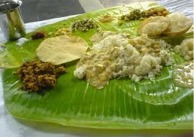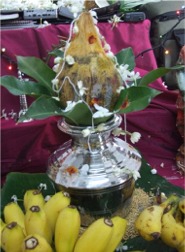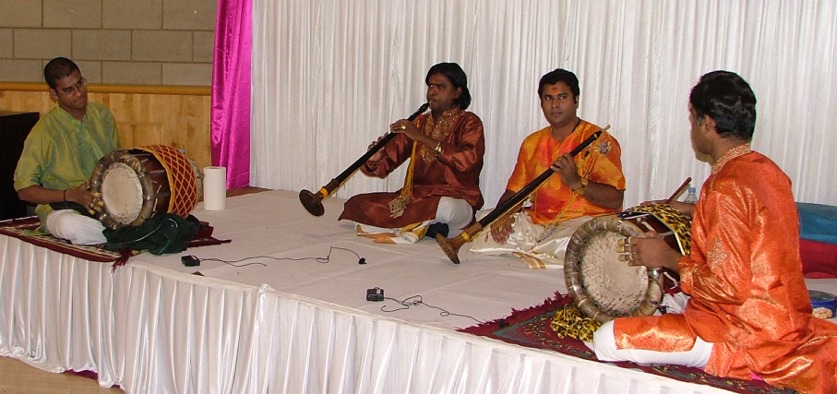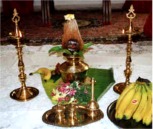Traditions & Customs - An Introduction
In writing these articles on Traditions & Customs, Tamil Hindu culture, Tamil beliefs and Superstitions and Thesavalamai, many hours of work have been put into referencing, collecting and collating all the information.
Although a lot of care had been taken to ensure the accuracy of the information given, there is no doubt that there will be some errors and omissions which in our opinion are inevitable and we regret these errors and omissions. If any users come across any such errors and omissions, please write to us through the ‘contact us' page and we will amend them appropriately.
Thank you for your support and please enjoy reading these articles and let know what you think. -- Admin
There are some formalities or events that appear now and again during the ceremonies described under the heading ‘Jaffna customs and Traditions' and these need some explanation.
When a turban is worn round the head of a man who is taking part in religious ceremony, it is to show respect to God.
Meals at the ceremony

Vegetarian meal served on Banana leaf
Following every ceremony where guests are invited, they are treated with a meal, usually rice and vegetarian curries. These are cooked in the premises on that day using fresh vegetables and the friends and relatives help in their own way to create this wonderful tasty meal.
The tradition is men eat first and the host or his sons go to each guest and invite them to join them at the meal by offering them a brass pot with water. Usually after a wedding the meal would be at the bride's house and the first person to be invited to join in would be the groom's father. Others follow him. The water is to wash their hands. Omission will offend the guest! The people sit on the floor on a mat or carpet in a row with their feet tucked underneath the opposite knee - known as Sukha Aasanam (comfortable pose - சப்பாணி). Food is served on an already washed banana leaf the tip of which faces the left hand side of the person seated. A tumbler of water is kept along with the banana leaf. Little water is sprinkled on the leaf and wiped away in order to symbolically wash the leaf. The first item to be served is salt. The curries are served one after the other along the upper edge of the leaf and rice is served in the centre of the leaf. The last curry to be served would be dhal curry - Payatham parippu which is the dhal curry always at a ceremonial meal, served on top of the rice. Once the dhal curry is served melted ghee is served on the dhal curry and then everyone can start eating. Serving of ghee signals the start to eat. Some fried things like fried ash plantain, fried buttermilk chillies and papadam will be served as well.
More rice and curries will be served continuously and yoghurt, butter milk and sodhi would be served towards the end. The last thing to be served would be vadai, banana fruit and payasam to complete the meal. Once everyone has finished eating they will fold the leaf towards them at the mid rib and rise, leaving the banana leaf behind, to wash their hands. The leaf will be collected by the hosts immediately. There will be betel chew and cigars available for those who chew and smoke. Once the men have finished their meal, women will be invited by the host and his wife to participate in the meal and the process is the same as for the men. This is a complete meal at a ceremony. The way the people are seated and food served on banana leaf is referred to as Panthi (பந்தி).
Breaking of coconut
At every religious ceremony coconuts are broken and an explanation is given as to the significance. There are different explanations to this event;
When a coconut is broken the person, usually a male, who breaks it will wear a turban round his head and be seated in Sukha Aasanam in front of a metal vessel. He will hold the coconut in one hand and break it with a heavy knife and will have to make sure the coconut is split in two equal halves without splintering. The water is let out into the vessel and the fibre tip is removed to expose the three eyes. Then he would place the coconut halves where they are needed.
The coconut without its tuft of fibre at the top exposes the three eyes which make the coconut look like the head of a human, the coconut is broken symbolising the breaking of ego. The coconut water represents the inner tendencies, and the white kernel represents the mind. Thus we surrender our mind to the Lord by breaking a coconut.
Every part of the coconut tree is usable thus offering of the coconut symbolises selfless service.
A coconut with its fibrous covering has the capacity to grow. By breaking the coconut, expelling the water and removing the tuft of fibre on top incapacitates the coconut from growing. There was a custom of human sacrifice very long time ago and later replaced by animal sacrifice which also has disappeared. But the sense of sacrifice has been kept in a sensible way with the breaking of coconut.
Aalaththi -ஆலாத்தி
At the start and completion of ceremonies, an Aalaththi is performed by two married women in front of the persons involved.
In a tray made of silver or brass, slaked lime (Chunnampu - சுண்ணாம்பு) is dissolved in water and turmeric powder is added and this water turns red, resembling blood. On this tray three pieces of banana are kept with a wick (Thiri - திரி) inserted in each. These wicks are soaked in oil and lit up. This tray is held by two married women on opposite end of the tray, in front of the person or persons for whom the Aalathi is performed and the tray is swayed to and fro three times and then raised and swirled around once. This swaying and swirling is repeated three times after which the lights are put off and a red pottu using the fluid in the tray is placed on the forehead of the person to whom this is done. The red liquid is a substitute for blood and Aalaththi is a substitute for blood spilling to ward off evil spirits.
Music at ceremonies
Nathaswaram & Thavil
At all ceremonies and at temples, ceremonial music is played and this is called Nathaswaram, a wind instrument accompanied by Thavil which is a drum. Although this is noisy, is a very pleasant music to listen. At important points at the ceremony this music is played at a peak shutting any external noises like sneezing, cursing etc.
Similarly at funeral ceremonies, Parai Melam (பறைமேளம்) is played and is characteristics of funerals only. It is not pleasant to listen. This drum is also played in any Amman temples at festival times.
Role of Kudi Makkal - குடிமக்கள்கடமை
Kudi Makkal is a term used to describe two clans of family servants; dhobi for washing clothes and barber for hair dressing. They serve all the family members and they are an essential part of the family affairs and are necessary to carry out the special duties at ceremonies and celebrations of the family and its members, for which they receive money, food and clothing as appropriate.
Also according to Thesavalamai, at a marriage ceremony when both parties getting married cannot afford the services of a priest, then in addition to the relatives, the family Vannan (Dhobi) and Ambaddan (barber) should be present to witness the wedding. So they were important clans even from ancient times in Jaffna.
Pottu - பொட்டு
The Pottu also called Thilakam invokes a feeling of sanctity in the wearer and others. It is also recognised as a religious mark. Its colour varies according to the status of the person who wears it. It is usually worn between the eye brows in the forehead.
A black pottu is worn by babies, children and by girls to remove any evil eyes. When anyone looks at a child, their attention is first on this pottu. This is made by dry roasting sago in a pan until it turns black. Then it is boiled in water and simmered to a thick consistency and sieved through into a coconut shell and allowed to dry. A drop of water is applied to this dried material to make a paste which is applied on the forehead.
Kunkuma pottu is worn by married women usually and sometimes by those who had been to Amman temples where Kunkumam is given as Prasadam by the priest. Santhana pottu is worn by both men and women at ceremonies and after returning from temples.
Kumbam - கும்பம்

Kumbam
A brass or silver pot which is woven with white thread is filled with clean fresh water; a coconut with three, five or seven mango leaves is placed on the mouth of this pot. The mango leaves are spread round the coconut. Any kind of flower can be placed on top of the coconut. A small piece of cloth called Vasthiram (வஸ்திரம்) is tied round the neck of the pot. Santhanam and kunkuma pottu can be placed on the coconut and on the body of the pot for decoration. This is called the Kumbam (கும்பம்). It is essential that he pot is filled with water. In almost all rituals, the officiating priest will invoke the Gods, perform pooja and purify and bless the water in the pot through mantras.
The Vedha (வேதங்கள்) states that the world, its beings and the souls originated from water during creation and disappear in water during destruction. The pot represents the flesh, water the blood, the thread are the nerves etc. This is the significance of the Kumbam. The mango leaves are capable of purifying the air and water and hence air pollution will be under control and the water in the pot will be purified.
Nirai Kudam -நிறைகுடம்
Nirai Kudam
Nirai Kudam is something that is placed at the entrance of the house in any ceremonies as a sign of welcome. On a table covered with a white cloth, a banana leaf is placed and paddy or raw rice is spread on it. A Kumbam as described above is placed in the middle of the paddy or rice.
On either side of the Kumbam are two oil lamps - Kuththu Vizakku (குத்துவிழக்கு) where the wicks are lit. An idol of Lord Vinayagar (see below) is placed on the banana leaf. Also a bunch of bananas, betel leaf with areca nut and a lime are placed on a tray which is placed on the table. Another tray with three small silver pots, containing Santhanam (சந்தனம்), Kunkumam (குங்குமம்) and the third with holy ash and a Panneer Kumbam (பன்நீர்கும்பம்) containing diluted rose water is also placed on the table. A betel leaf on which lies a single banana where some incense sticks are lit and inserted so that they stand erect is placed on the table.
Goddess Lakshmi resides in betel leaves and is used in all auspicious events. Taste of lime is always sour whether it is ripe or raw. Likewise, one has to maintain a stable mentality in both misery and happiness. This is revealed through lime and it is significant for divine worship. Everyone should lead a life which is appreciated as that of noble character just like the fragrance of the Panneer which is liked by everyone. These are some of the philosophies associated with some items here.
Vinayagar idol
Everything in a Hindu ceremony happens after prayers to Lord Vinayagar and invoking his blessings to avoid any misfortunes and obstacles during the ceremonies. He is supposed to be present wherever he is needed. So an idol is made of him and placed at celebrations. The idol is made from fresh cow dung or turmeric powder in the form of a small cone. Some Arugam pullu (அறுகம்புல்லு) is inserted on top of the cone. This now is an idol of Lord Vinayagar and this is placed wherever he is wanted. Arugam Pullu is a favourite of Lord Vinayagar and it will grow rampantly anywhere without its seed. Likewise, soul is indestructible and that is the philosophy.
Thudakku - துடக்கு
Thudakku is a term describing the religious impurity following child birth and death or coming of age and menstruation. Those who have Thudakku should not go to temples or participate in any religious activities during that period of Thudakku. In cases of child birth and death, the people in the house, those who have eaten in that house during this time, the mourners, the spouse and children of the dead, the male descendants on the father's or husband's ascending line ancestors will be considered to be having Thudakku for 31 days. After the 31 days this impurity is removed by cleaning and washing the house and everyone should have a head bath and wear washed clothes. A priest is invited to perform a special pooja which is called Punniyagavasanam (புண்ணியாகவாசனம்) and he purifies the house and everyone there. Blessed water will be sprinkled to every part of the house as a part of the ritual. The priest receives a TThetchanai (தட்சணை) in cash and kind for his services.
In cases of coming of age, the family members have Thudakku for four days when they have an oil bath and clean the house to get rid of the Thudakku. Some families invite a priest to perform Punniyagavasanam. In case of menstruation, Thudakku applies to the person concerned for three days after which period they have an oil bath and purify themselves.
Punniyagavasanam - புண்ணியாகவாசனம்
Punniyagavasanam is done by a Hindu priest before any religious ceremonies at homes and to remove any Thudakku at Anthiyeshti or after child birth ceremonies. Even at house warming ceremonies Punniyagavasanam is performed. The priest performs certain religious rituals and prayers, including Vinayagar pooja, by which he purifies himself, the environment and all items used in the ceremony. He also prepares the Panchakavviyam (பஞ்சகவ்வியம்) from five things obtained from a cow - milk, curd, ghee, kosalam and komayam. Very often milk is only used. This Panchakavviyam is mixed with the water in the Kumbam and he offers prayers to Lord Varna and the seven seas. He then offers this sacred water to the person concerned; that would be the bride and groom at a wedding or a married woman at the Anthiyeshti or child birth ceremony and they drink this three times from their palm. This purifies the internal organs including the soul and mind. When this is performed at homes, some of the water is sprinkled throughout the house in order to cleanse the property.
Fasting - விரதம்
Fasting is a way to worship to God with sincere devotion through mind, speech and body. It is a means of purification and self discipline. In fact fasting is the body’s natural way of dealing with illness and pain. In normal life much of our energy is spent on the process of digestion and resting the digestive system once a week releases this energy and allows the body to get rid of toxins and allows the organs to repair, rejuvenate and relax. On a fasting day one controls their mind and senses and meditate and pray. By controlling their food they can control their mind and hence people fast.
Certain days in a year are important for Hindus and most of the Hindus fast on these days. Generally Tuesdays, Saturdays, temple festival days, Hindu festival days and Saturdays in the months of September / October – Puraddasi Sani (புரட்டாசி சனி) are important days in a year for Hindus. Also dedicated Hindus fast in memory of their dead parents at their death anniversary. They carry out strict rituals on a fasting day; early bath, wear washed clean clothes and pray at home. Some go to temple and offer pooja or simply go to pray. They do not eat in the mornings and eat a vegetarian meal in the afternoon. Any stimulating food items like onion and garlic is avoided. At night a cup of milk and fruits is normal. Some people offer charity by offering food to orphanages, old people's home etc.








